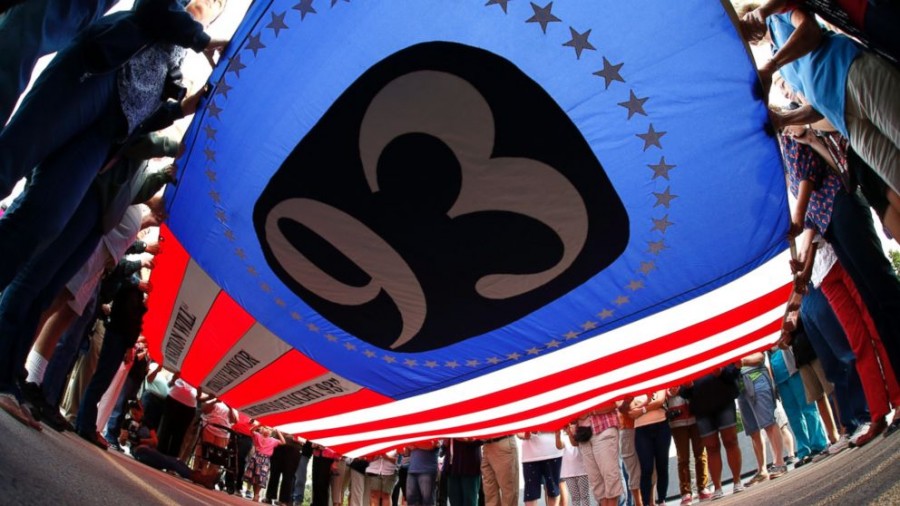
Visitors to the Flight 93 National Memorial hold a giant flag as they participate in a sunset memorial service at sunset on Wednesday, September 10, 2014. (AP Photo/Gene J. Puskar)
SHANKSVILLE, Pa. — On a tour of Flight 93 National Memorial work in progress, National Park Service officials expressed hope Wednesday the site would “keep the story alive” well beyond any anniversary of the September 11, 2001, terrorist attacks.
The memorial marks the spot where United Airlines Flight 93 crashed 13 years ago in a reclaimed strip mine some 75 miles southeast of Pittsburgh after passengers fought back against hijackers. All 33 passengers and seven crew members were killed.
Gordon Felt, president of the Families of Flight 93 support group, said the spot is a living memorial to those who died and brings peace to a place where violence occurred. Felt’s oldest brother, Edward, 41, was among the passengers who died in the crash.
“It helps one understand the juxtaposition of violence and peacefulness,” Felt said of the memorial, and more specifically, the visitor center and learning center being built on a plateau overlooking the crash site. “It’s not just a 93-foot statue in the middle of the field. It’s a living memorial.”
Jeff Reinbold, the superintendent of the memorial, and Keith Newlin, his deputy, said it was important to the National Park Service for the memorial to give visitors multiple vistas from which to reflect on the events of that day, as well as a way to learn more about the crash.
A memorial plaza was completed in time for the 10th anniversary. It features a white stone wall with separate panels for each victim, with one name engraved on each. The wall traces the path of the doomed flight, and along with 40 groves of 40 trees are a way to focus attention on the crash site and the victims’ memories.
The centers under construction during the media tour are “more about how do we keep the story alive for future generations,” Reinbold said.
Newlin said the visitor center’s structure should be complete by June, which will give park officials three months to install exhibits in time to open for the 14th anniversary of the crash.
The visitor center will have a window overlooking the crash site in the distance, Newlin said, “so people may not have to go to the crash site if they don’t feel they can handle it.”
The building will also have a gap in it, also offering a vista on the crash site. Newlin said architect Paul Murdoch designed the memorial so visitors can pause at various spots to view the site from the rolling fields that surround it, which help focus on the deeper meaning of the park.
Murdoch wanted visitors “to have as many opportunities to reflect on what happened here, and the healing nature of the site,” Newlin said.
The visitor center’s concrete walls are being formed with molds that make the exterior look like the hemlock wood used on the sides of barns that dot the rural valley so the center fits with the landscape, Newlin said.
The earlier phase of the memorial, including the stone plaza wall and access roads, cost about $20.5 million. The visitor and learning centers are earmarked at between $17 million and $23 million, Newlin said.
Still to be completed are a 93-foot tall tower with 40 wind chimes near the park’s entrance. The tower and other access roads should cost another $3 million to $5 million, with the total cost of the park at about $60 million, Newlin said. The government spent another $10 million for the land.

